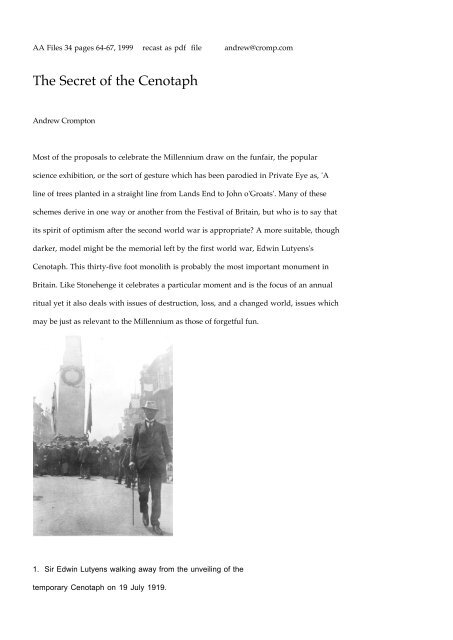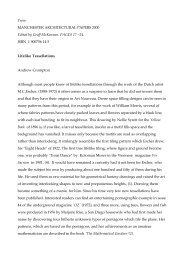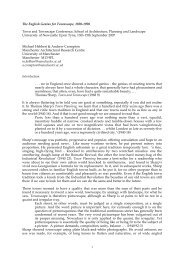The Secret of the Cenotaph
The Secret of the Cenotaph - Andrew Crompton
The Secret of the Cenotaph - Andrew Crompton
- No tags were found...
Create successful ePaper yourself
Turn your PDF publications into a flip-book with our unique Google optimized e-Paper software.
AA Files 34 pages 64-67, 1999 recast as pdf file andrew@cromp.com<br />
<strong>The</strong> <strong>Secret</strong> <strong>of</strong> <strong>the</strong> <strong>Cenotaph</strong><br />
Andrew Crompton<br />
Most <strong>of</strong> <strong>the</strong> proposals to celebrate <strong>the</strong> Millennium draw on <strong>the</strong> funfair, <strong>the</strong> popular<br />
science exhibition, or <strong>the</strong> sort <strong>of</strong> gesture which has been parodied in Private Eye as, 'A<br />
line <strong>of</strong> trees planted in a straight line from Lands End to John o'Groats'. Many <strong>of</strong> <strong>the</strong>se<br />
schemes derive in one way or ano<strong>the</strong>r from <strong>the</strong> Festival <strong>of</strong> Britain, but who is to say that<br />
its spirit <strong>of</strong> optimism after <strong>the</strong> second world war is appropriate? A more suitable, though<br />
darker, model might be <strong>the</strong> memorial left by <strong>the</strong> first world war, Edwin Lutyens's<br />
<strong>Cenotaph</strong>. This thirty-five foot monolith is probably <strong>the</strong> most important monument in<br />
Britain. Like Stonehenge it celebrates a particular moment and is <strong>the</strong> focus <strong>of</strong> an annual<br />
ritual yet it also deals with issues <strong>of</strong> destruction, loss, and a changed world, issues which<br />
may be just as relevant to <strong>the</strong> Millennium as those <strong>of</strong> forgetful fun.<br />
1. Sir Edwin Lutyens walking away from <strong>the</strong> unveiling <strong>of</strong> <strong>the</strong><br />
temporary <strong>Cenotaph</strong> on 19 July 1919.
<strong>The</strong> story <strong>of</strong> its creation is well known. In July 1919 <strong>the</strong> Prime Minister, Lloyd George,<br />
gave Lutyens fourteen days to produce a temporary monument for <strong>the</strong> Peace Celebrations<br />
to act as a tribute to <strong>the</strong> nearly million dead <strong>of</strong> <strong>the</strong> Empire. Lutyens thought <strong>of</strong> <strong>the</strong> name,<br />
had his sketch proposals accepted within six hours, and <strong>the</strong>n arranged for a wood and<br />
plaster structure to be erected in <strong>the</strong> time allowed. 1 It met with such immediate popular<br />
acclaim for its stern majesty that it was rebuilt in Portland Stone for Remembrance Day in<br />
1920. Lutyens asked for no fee and was not even invited to <strong>the</strong> unveiling (Fig. 1). He had<br />
been a well known architect when he accepted <strong>the</strong> commission and his design made him<br />
famous. As a result <strong>of</strong> public opinion <strong>the</strong> <strong>Cenotaph</strong> survived to become Britain's <strong>of</strong>ficial<br />
memorial (Fig. 2). Why did ordinary people respond to it so strongly?<br />
Proposals to celebrate <strong>the</strong> victories <strong>of</strong> totalitarian powers this century, whe<strong>the</strong>r real or<br />
imaginary, such as Franco's colossal cross at Valle des los Caidos, or Albert Speer's plans<br />
for a 240-foot-high triumphal arch in Berlin, all involved stupendous expense, slave<br />
labour and an explicit expression <strong>of</strong> political power. Yet <strong>the</strong> <strong>Cenotaph</strong> not only has<br />
probably stirred deeper feeling but has enjoyed more genuine popular regard. Could it be<br />
that it works by invoking an unconscious reaction, by pointing to something to which we<br />
are predisposed to respond? Curiously one <strong>of</strong> Lutyens' drawings suggests that <strong>the</strong> geometry<br />
<strong>of</strong> his design may conceal an image which could affect us in this way. If this is so <strong>the</strong>n his<br />
work functions in a way which is nowadays more likely to be associated with<br />
motivational research and advertising than architecture.<br />
Seen today on a walk down Whitehall it appears, as do many great works, smaller than<br />
it does in a photograph, yet it has a strong presence and gravity. Its simple silhouette,<br />
familiar and at <strong>the</strong> same time strange, conceals subtle complications in its setbacks which<br />
lead <strong>the</strong> eye up and round. <strong>The</strong> inscription which does not celebrate victory, or even 'Our<br />
Glorious Dead' but <strong>The</strong> Glorious Dead, is nicely understated. It owes little to its site, its<br />
position in <strong>the</strong> middle <strong>of</strong> <strong>the</strong> road where it acts as a traffic refuge seems almost<br />
accidental, in any case <strong>the</strong> <strong>Cenotaph</strong> has <strong>the</strong> unusual distinction for a work <strong>of</strong>
architecture <strong>of</strong> not being unique. <strong>The</strong>re are at least fifty-five copies in Britain and o<strong>the</strong>rs<br />
overseas 2 . Moreover, <strong>the</strong>se vary in <strong>the</strong>ir size and embellishment: some have a soldier<br />
sleeping on top ra<strong>the</strong>r than <strong>the</strong> wreath, o<strong>the</strong>rs have a sword carved point down on <strong>the</strong><br />
side. One surreal version in France, in <strong>the</strong> military cemetery in Etaples, even has an arch<br />
driven through it and is finished with pinnacles on <strong>the</strong> corners in <strong>the</strong> form <strong>of</strong> drooping<br />
carved stone flags which look like umbrellas, yet <strong>the</strong> basic form <strong>of</strong> <strong>the</strong> <strong>Cenotaph</strong> is still<br />
plain to see (Fig 3). All take part in <strong>the</strong> synchronised ceremony when at <strong>the</strong> solemn<br />
moment <strong>of</strong> <strong>the</strong> eleventh <strong>of</strong> <strong>the</strong> eleventh <strong>of</strong> <strong>the</strong> eleventh <strong>the</strong>y are served in silence and<br />
<strong>of</strong>fered paper flowers. This suggests that <strong>the</strong>y achieve <strong>the</strong>ir effect not by virtue <strong>of</strong> <strong>the</strong>ir<br />
size or details, but because <strong>the</strong>re is something evocative about <strong>the</strong>ir basic form,<br />
2. <strong>The</strong> <strong>Cenotaph</strong> on Armistice Day, 1920.<br />
<strong>The</strong> story <strong>of</strong> its magical creation in an evening is part <strong>of</strong> its legend, but more than likely<br />
that Lutyens had his idea ready when he met Lloyd George. 3 For <strong>the</strong> previous year he<br />
had been working for <strong>the</strong> Imperial War Graves Commission, designing for <strong>the</strong> Allied war<br />
cemeteries in France a memorial from which <strong>the</strong> <strong>Cenotaph</strong> is clearly descended. In this<br />
work he pursued an abstract approach in spite <strong>of</strong> an influential lobby which favoured a<br />
design based on <strong>the</strong> Cross, partly because <strong>the</strong> dead had been <strong>of</strong> many different faiths, and
partly because <strong>of</strong> his own <strong>the</strong>osophical beliefs, which encouraged a pan<strong>the</strong>istic<br />
pan<strong>the</strong>istic outlook. His first idea had been for a huge bronze sphere, but he eventually<br />
settled on <strong>the</strong> Great Stone, a finely proportioned horizontal block with a simple<br />
inscription (Fig 4). <strong>The</strong> form <strong>of</strong> <strong>the</strong> Stone is more sophisticated than it appeared at first<br />
sight. Its faces, which seem flat, are, actually parts <strong>of</strong> a sphere with a radius <strong>of</strong> ninehundred<br />
feet.<br />
3. <strong>Cenotaph</strong> in <strong>the</strong> military cemetery at Etaples.<br />
Entasis, a refinement <strong>of</strong> Greek architecture in which surfaces are imperceptibly curved<br />
and verticals angled slightly out <strong>of</strong> plumb, best known from its application to <strong>the</strong><br />
Par<strong>the</strong>non, has been <strong>the</strong> subject <strong>of</strong> much study and speculation. <strong>The</strong> slight distortions it<br />
introduces are very hard to see; as with homeopathy <strong>the</strong> effect is so diluted that one may<br />
reasonably doubt that anything is actually happening. Although its original purpose is<br />
not known it is <strong>of</strong>ten held to be a sort <strong>of</strong> anti-optical illusion which makes buildings<br />
appear more perfectly square and upright by compensating for natural defects in our<br />
vision. It is, however, a striking fact that <strong>the</strong> entasis preserves in <strong>the</strong> Stone a magnified<br />
image <strong>of</strong> Lutyens’s original sphere.
4 . Photograph showing an example <strong>of</strong> <strong>the</strong> Great Stone designed by<br />
Lutyens for <strong>the</strong> Allied war cemeteries, (date and location unknown).<br />
<strong>The</strong> use <strong>of</strong> entasis to imply a secret form was an unusual and probably original idea. In <strong>the</strong><br />
<strong>Cenotaph</strong> he took it even fur<strong>the</strong>r. Drawings show that he intended <strong>the</strong> vertical sides to<br />
taper to meet at a point a thousand feet in <strong>the</strong> air, and <strong>the</strong> horizontal lines to be part <strong>of</strong> a<br />
circle with a centre nine-hundred feet below <strong>the</strong> ground (Fig. 5). 4 This connects a point in<br />
<strong>the</strong> air with a point in <strong>the</strong> earth on a gigantic scale, like a sort <strong>of</strong> spiritual lightening<br />
conductor. Lutyens pushed his entasis to <strong>the</strong> point <strong>of</strong> invisibility, a calculation shows<br />
that his proposals should cause <strong>the</strong> band courses to rise by 6 mm at <strong>the</strong>ir centre. Sad to<br />
say, if <strong>the</strong> <strong>Cenotaph</strong> is examined today this swelling cannot be seen, although it is hard<br />
to be certain because <strong>the</strong> surface has roughened with age. <strong>The</strong> sides, however, do seem to<br />
slope slightly. <strong>The</strong> entasis, if indeed it was ever incorporated properly, is so faint as to be<br />
indiscernible.<br />
What could be <strong>the</strong> purpose <strong>of</strong> an invisible refinement? Besides concealing an image which<br />
indicates how <strong>the</strong> structure is to be read, <strong>the</strong> entasis reinforces <strong>the</strong> Greek character <strong>of</strong> <strong>the</strong><br />
In a study <strong>of</strong> <strong>the</strong> relationship between ancient Greek art and geometry W.M. Ivins<br />
pointed out that both disciplines only used relationships which can be understood by<br />
hand ra<strong>the</strong>r than <strong>the</strong> eye, this for him being a distinctive trait <strong>of</strong> thought in ancient<br />
Greece. 5 Euclid, for example says that parallel lines do not meet, this being how <strong>the</strong>y feel<br />
to <strong>the</strong> hand, whereas <strong>the</strong> modern eye sees <strong>the</strong>m as converging to meet on <strong>the</strong> horizon. Ivins
traces similar traits in Greek sculpture which he said was poor at unifying separate<br />
figures or depicting figures in motion, exactly <strong>the</strong> sort <strong>of</strong> relationships which <strong>the</strong> eye can<br />
understand but <strong>the</strong> hand cannot.<br />
Now, <strong>the</strong> hand alone cannot tell if three points lie on a straight line, this being<br />
essentially a visual relationship, and for <strong>the</strong> Greeks whe<strong>the</strong>r three points lined up from<br />
a particular point <strong>of</strong> view does not seem to have been important. This may be seen in <strong>the</strong><br />
plan <strong>of</strong> <strong>the</strong> Acropolis where <strong>the</strong> buildings are arranged in an apparently haphazard<br />
manner. This suggests that slightly curving lines <strong>of</strong> entasis were used by default because<br />
exactly straight lines were not thought <strong>of</strong> as special. Understood from this point <strong>of</strong> view<br />
Greek architecture and its entasis is a natural result <strong>of</strong> a tactile and sensuous approach<br />
ra<strong>the</strong>r than a visual and distant one.<br />
5. Diagram showing <strong>the</strong> battered sides and curved band courses <strong>of</strong> <strong>the</strong> <strong>Cenotaph</strong>
<strong>The</strong> <strong>Cenotaph</strong> feels as if it was designed for <strong>the</strong> hand ra<strong>the</strong>r than <strong>the</strong> eye. Its colourless<br />
form and details are simple such as a hand could read, it stands alone, avoids straight<br />
lines and has no internal space. Its opposite in all <strong>the</strong>se respects is <strong>the</strong> Albert Memorial<br />
whose complexity, axial siting, internal space and rich finishes would baffle a blind man.<br />
Albert on his throne keeps <strong>the</strong> viewer at a distance but <strong>the</strong> <strong>Cenotaph</strong>, like most sculpture,<br />
invites touch. Whilst its abstract form avoids resembling anything too directly, it is<br />
different from <strong>the</strong> abstract purity <strong>of</strong> much modernist architecture which is so <strong>of</strong>ten devoid<br />
<strong>of</strong> poetic resonance. What could it be? Perhaps <strong>the</strong> right question to ask is not what does<br />
it look like, but what does it feel like?<br />
<strong>The</strong> curved bands point to a root deep in <strong>the</strong> earth, <strong>the</strong> sloping sides project <strong>the</strong> wreath on<br />
top a thousand feet in <strong>the</strong> air, it joins heaven and <strong>the</strong> grave, but <strong>the</strong>re is more to it than<br />
that. This extract from Kipling's poem <strong>of</strong> 1922 6 describing <strong>the</strong> cemeteries in France comes<br />
close to capturing Lutyens’s secret <strong>the</strong>me;<br />
A carven Stone, and a stark Sword brooding on <strong>the</strong> bosom <strong>of</strong> <strong>the</strong> Cross<br />
Where high and low are one.<br />
Notice that <strong>the</strong> shallow steps around <strong>the</strong> <strong>Cenotaph</strong> are joined to <strong>the</strong> vertical faces with<br />
a little curve and may be read as an integral part <strong>of</strong> <strong>the</strong> whole structure not just a base on<br />
which <strong>the</strong> main block happens to stand. Seen in this way <strong>the</strong> monolith becomes a grip<br />
with <strong>the</strong> steps as a hand guard, and taken toge<strong>the</strong>r <strong>the</strong> whole thing becomes a sword<br />
shea<strong>the</strong>d by driving it into <strong>the</strong> earth. Which sword could it be? <strong>The</strong>re can only be one, it<br />
comes from <strong>the</strong> oldest story in Britain, a story <strong>of</strong> a magician, a magic sword, a great king<br />
and sleeping army which will reawaken when <strong>the</strong> nation is in peril. It may be that his is<br />
<strong>the</strong> form which is unconsciously recognised and which gives <strong>the</strong> <strong>Cenotaph</strong> its power.<br />
<strong>The</strong> sword in question appeared mysteriously in a graveyard. Though familiar and<br />
scarcely noticed by <strong>the</strong> public, once a year it is jealously attended by royalty, and
understandably so, for it will be consulted if <strong>the</strong> line <strong>of</strong> succession fails. It is frozen in<br />
stone, and waits patiently for an unknown soldier to free it. It waits for Arthur, because <strong>of</strong><br />
course <strong>the</strong> <strong>Cenotaph</strong> is nothing less than <strong>the</strong> hilt <strong>of</strong> Excalibur itself.<br />
Whoso Pulleth Out This Sword <strong>of</strong> this Stone and Anvil, is Rightwise King Born <strong>of</strong> all<br />
England. 7<br />
If <strong>the</strong> Great War marked an end <strong>of</strong> a sort for Britain how very fitting that it should be<br />
remembered with something from its very beginning. And what better way <strong>of</strong> celebrating<br />
<strong>the</strong> Millennium than by discovering a way <strong>of</strong> reviving this sort <strong>of</strong> solemn power in<br />
architecture.<br />
NOTES<br />
1. Christopher Hussey, <strong>The</strong> Life <strong>of</strong> Sir Edwin Lutyens London 1950<br />
2. A survey by <strong>the</strong> Imperial War Museum has identified 55 cenotaphs in Britain, out<br />
<strong>of</strong> 5.600 Great War memorials so far recorded. Interesting examples may be found<br />
in Manchester, Derby, Glasgow and Hong Kong.<br />
3. Allan Greenberg, ‘Lutyens’s <strong>Cenotaph</strong>’, Journal <strong>of</strong> <strong>the</strong> Society <strong>of</strong> Architectural<br />
Historians vol. 48 (March 1989).<br />
4. A. S. G. Butler, <strong>The</strong> Architecture <strong>of</strong> Sir Edwin Lutyens (<strong>The</strong> Lutyens Memorial)<br />
London 1950.<br />
5. William M. Ivins Jr, Art and Geometry: A Study in Space Intuitions (Harvard<br />
University Press, 1946).<br />
6. ‘<strong>The</strong> Kings Pilgrimage’, 1922.<br />
7. Sir Thomas Mallory, Morte d'Arthur, book 1 chapter 4.<br />
Fig. 1: Courtesy <strong>of</strong> Jane Ridley<br />
Fig. 2: Imperial War Museum (Q31498)<br />
Fig. 3,4: Commonwealth War Graves Commission.<br />
Fig. 5: Drawing from A.S.G. Butler’s <strong>The</strong> Architecture <strong>of</strong> Sir Edwin Lutyens, adapted by<br />
<strong>the</strong> author.




